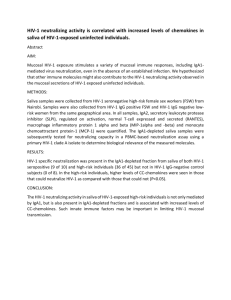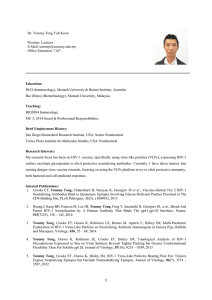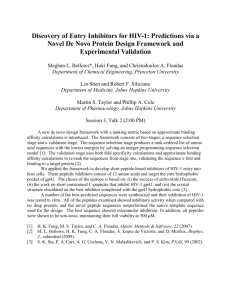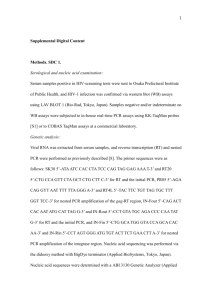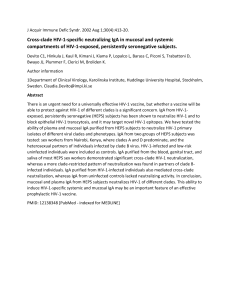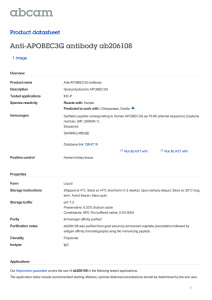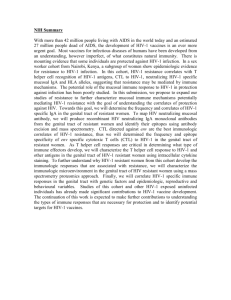gp120/CD4 Blocking Antibodies Are Frequently Elicited in ART
advertisement
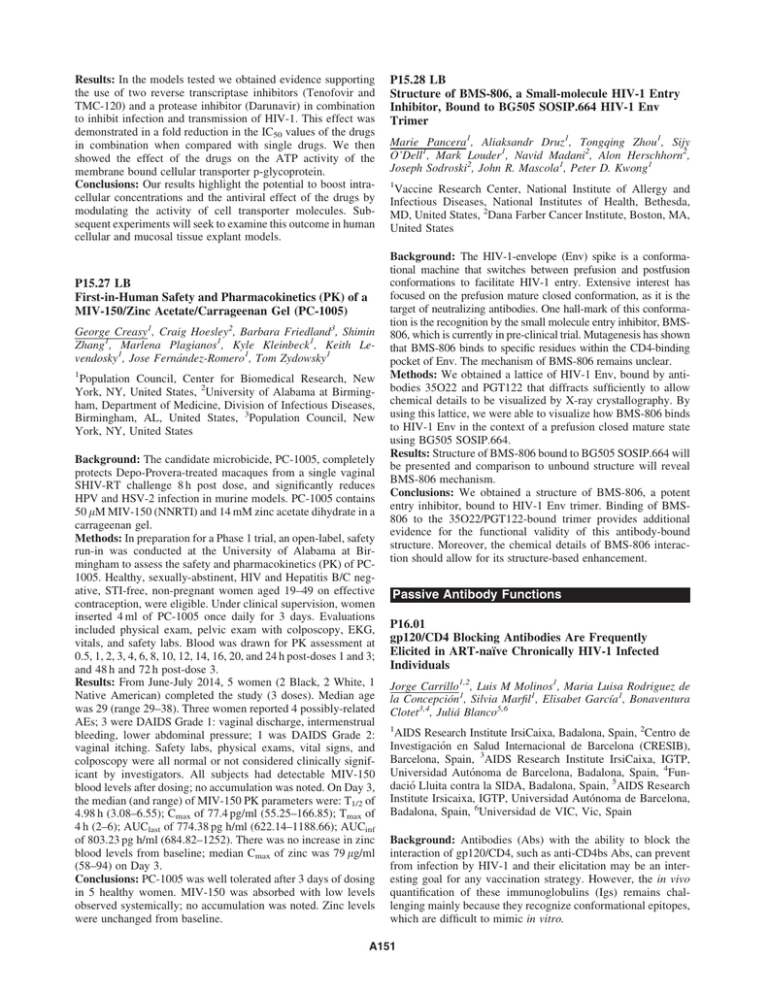
Results: In the models tested we obtained evidence supporting the use of two reverse transcriptase inhibitors (Tenofovir and TMC-120) and a protease inhibitor (Darunavir) in combination to inhibit infection and transmission of HIV-1. This effect was demonstrated in a fold reduction in the IC50 values of the drugs in combination when compared with single drugs. We then showed the effect of the drugs on the ATP activity of the membrane bound cellular transporter p-glycoprotein. Conclusions: Our results highlight the potential to boost intracellular concentrations and the antiviral effect of the drugs by modulating the activity of cell transporter molecules. Subsequent experiments will seek to examine this outcome in human cellular and mucosal tissue explant models. P15.27 LB First-in-Human Safety and Pharmacokinetics (PK) of a MIV-150/Zinc Acetate/Carrageenan Gel (PC-1005) George Creasy1, Craig Hoesley2, Barbara Friedland3, Shimin Zhang1, Marlena Plagianos1, Kyle Kleinbeck1, Keith Levendosky1, Jose Fernández-Romero1, Tom Zydowsky1 1 Population Council, Center for Biomedical Research, New York, NY, United States, 2University of Alabama at Birmingham, Department of Medicine, Division of Infectious Diseases, Birmingham, AL, United States, 3Population Council, New York, NY, United States Background: The candidate microbicide, PC-1005, completely protects Depo-Provera-treated macaques from a single vaginal SHIV-RT challenge 8 h post dose, and significantly reduces HPV and HSV-2 infection in murine models. PC-1005 contains 50 lM MIV-150 (NNRTI) and 14 mM zinc acetate dihydrate in a carrageenan gel. Methods: In preparation for a Phase 1 trial, an open-label, safety run-in was conducted at the University of Alabama at Birmingham to assess the safety and pharmacokinetics (PK) of PC1005. Healthy, sexually-abstinent, HIV and Hepatitis B/C negative, STI-free, non-pregnant women aged 19–49 on effective contraception, were eligible. Under clinical supervision, women inserted 4 ml of PC-1005 once daily for 3 days. Evaluations included physical exam, pelvic exam with colposcopy, EKG, vitals, and safety labs. Blood was drawn for PK assessment at 0.5, 1, 2, 3, 4, 6, 8, 10, 12, 14, 16, 20, and 24 h post-doses 1 and 3; and 48 h and 72 h post-dose 3. Results: From June-July 2014, 5 women (2 Black, 2 White, 1 Native American) completed the study (3 doses). Median age was 29 (range 29–38). Three women reported 4 possibly-related AEs; 3 were DAIDS Grade 1: vaginal discharge, intermenstrual bleeding, lower abdominal pressure; 1 was DAIDS Grade 2: vaginal itching. Safety labs, physical exams, vital signs, and colposcopy were all normal or not considered clinically significant by investigators. All subjects had detectable MIV-150 blood levels after dosing; no accumulation was noted. On Day 3, the median (and range) of MIV-150 PK parameters were: T1/2 of 4.98 h (3.08–6.55); Cmax of 77.4 pg/ml (55.25–166.85); Tmax of 4 h (2–6); AUClast of 774.38 pg h/ml (622.14–1188.66); AUCinf of 803.23 pg h/ml (684.82–1252). There was no increase in zinc blood levels from baseline; median Cmax of zinc was 79 lg/ml (58–94) on Day 3. Conclusions: PC-1005 was well tolerated after 3 days of dosing in 5 healthy women. MIV-150 was absorbed with low levels observed systemically; no accumulation was noted. Zinc levels were unchanged from baseline. P15.28 LB Structure of BMS-806, a Small-molecule HIV-1 Entry Inhibitor, Bound to BG505 SOSIP.664 HIV-1 Env Trimer Marie Pancera1, Aliaksandr Druz1, Tongqing Zhou1, Sijy O’Dell1, Mark Louder1, Navid Madani2, Alon Herschhorn2, Joseph Sodroski2, John R. Mascola1, Peter D. Kwong1 1 Vaccine Research Center, National Institute of Allergy and Infectious Diseases, National Institutes of Health, Bethesda, MD, United States, 2Dana Farber Cancer Institute, Boston, MA, United States Background: The HIV-1-envelope (Env) spike is a conformational machine that switches between prefusion and postfusion conformations to facilitate HIV-1 entry. Extensive interest has focused on the prefusion mature closed conformation, as it is the target of neutralizing antibodies. One hall-mark of this conformation is the recognition by the small molecule entry inhibitor, BMS806, which is currently in pre-clinical trial. Mutagenesis has shown that BMS-806 binds to specific residues within the CD4-binding pocket of Env. The mechanism of BMS-806 remains unclear. Methods: We obtained a lattice of HIV-1 Env, bound by antibodies 35O22 and PGT122 that diffracts sufficiently to allow chemical details to be visualized by X-ray crystallography. By using this lattice, we were able to visualize how BMS-806 binds to HIV-1 Env in the context of a prefusion closed mature state using BG505 SOSIP.664. Results: Structure of BMS-806 bound to BG505 SOSIP.664 will be presented and comparison to unbound structure will reveal BMS-806 mechanism. Conclusions: We obtained a structure of BMS-806, a potent entry inhibitor, bound to HIV-1 Env trimer. Binding of BMS806 to the 35O22/PGT122-bound trimer provides additional evidence for the functional validity of this antibody-bound structure. Moreover, the chemical details of BMS-806 interaction should allow for its structure-based enhancement. Passive Antibody Functions P16.01 gp120/CD4 Blocking Antibodies Are Frequently Elicited in ART-naı̈ve Chronically HIV-1 Infected Individuals Jorge Carrillo1,2, Luis M Molinos1, Maria Luisa Rodriguez de la Concepción1, Silvia Marfil1, Elisabet Garcı́a1, Bonaventura Clotet3,4, Juliá Blanco5,6 1 AIDS Research Institute IrsiCaixa, Badalona, Spain, 2Centro de Investigación en Salud Internacional de Barcelona (CRESIB), Barcelona, Spain, 3AIDS Research Institute IrsiCaixa, IGTP, Universidad Autónoma de Barcelona, Badalona, Spain, 4Fundació Lluita contra la SIDA, Badalona, Spain, 5AIDS Research Institute Irsicaixa, IGTP, Universidad Autónoma de Barcelona, Badalona, Spain, 6Universidad de VIC, Vic, Spain Background: Antibodies (Abs) with the ability to block the interaction of gp120/CD4, such as anti-CD4bs Abs, can prevent from infection by HIV-1 and their elicitation may be an interesting goal for any vaccination strategy. However, the in vivo quantification of these immunoglobulins (Igs) remains challenging mainly because they recognize conformational epitopes, which are difficult to mimic in vitro. A151 Methods: The presence of gp120/CD4 blocking Abs in plasma samples from 36 ART-naı̈ve Chronic HIV-1 infected patients and 10 uninfected healthy controls was evaluated by a competitive flow cytometry assay using a huCD4/murine-IgG1 fusion protein. Anti-CD4bs Abs were quantified by ELISA using resurfaces proteins RSC3 and RSC3D371I. Neutralization activity of plasma samples was determined by a TZM-bl-based neutralization assay. Results: 35 out of 36 HIV-1 infected patients showed CD4/ gp120 blocking Abs. No correlation with anti-CD4bs ELISA data was observed suggesting that not all anti-CD4bs Abs showed gp120/CD4 blocking capacity. In addition, 10 out of 36 plasma samples lacking anti-CD4bs Abs in ELISA assays were able to block the interaction between gp120 and its receptor indicating that Abs recognizing other epitopes can play a similar role. Although a poor correlation between gp120/CD4 blocking Abs and viral load was established, these Igs were developed mainly in patients with viral load higher than 5000 copies/mL and maintained at least during one year. These Abs correlated with the neutralizing capacity of plasma samples suggesting that they can contribute to the neutralizing workforce of plasma. Conclusions: The frequency of Abs capable of blocking the interaction between CD4 and gp120 in HIV-1 infected patients was higher than previously expected, bringing together several specificities such as the CD4bs but also other undefined epitopes. The characterization of this CD4/gp120 blocking response may provide valuable information for the design of a successful vaccine. P16.02 Sequence Characteristics of HIV-1 B’ Envelope Proteins and its Potential Correlation with Broadly Neutralizing Activity Yanli Chen, Yuanyuan Hu, Zhenpeng Li, Li Ren, Liying Ma, Yuhua Ruan, Kunxue Hong, Yiming Shao National Center for AIDS/STD Control and Prevention, Chinese Center for Disease Control and Prevention, Beijing, China Background: Current HIV-1 vaccine strategies fail to elicit broadly neutralizing antibodies(BnAbs). Further understanding of the mechanisms of induction of BnAbs in natural HIV-1 infection will provide insights on improving the current vaccine strategies. The aim of this study is to identify samples with BnAbs activities from HIV-1 B’ infected individuals and to explore potential sequence characteristics of env genes which correlate with broadly neutralizing activity. Methods: Using a panel of 25 Env-pseudoviruses including HIV-1 clade B, C, A, CRF07_BC and CRF01_AE strains, six samples with BnAbs activities were identified from 103 samples with chronic HIV-1 B’ infection. 164 env sequences were amplified by single genome amplification assay from these six samples and sequence characteristics were analyzed. Results: Each of these six samples with BnAbs activities was able to neutralize more than 80% test strains, in which the neutralizing breadth for clade B strains is the biggest. Sequence analysis indicated the genetic diversity mainly lied in V1V2, V4, and V5 sub-regions; env genes from these samples have a longer length and more glycosylation sites at V1V2,V4 regions, but less net charge at V3 loop; preliminary sequence analysis demonstrated env genes from these samples have escape mutations in key sites of 10E8, 2G12, PGT127/128 and PG6/PG9 epitopes, and the proportion was 77.8%, 30.6%, 27.8% and 13.9% respectively. In addition, 46 specific sites and 8 co-variation patterns were identified in env genes, which may be associated with broadly neutralization activity. Conclusions: This study demonstrated that a relatively high prevalence of BnAbs responses was detected in chronic HIV-1 B¢ infection. Sequence analysis suggested that HIV-1 may escape neutralization via increasing length and the glycosylation of V1V2 and V4 loop and reducing V3 ring static charge, and different epitomes of HIV-1 env genes from samples with BnAbs activities endure varying immune pressures. P16.03 Investigating Broad Neutralization in HIV-1 Non-B Subtype Infection in Yaoundé, Cameroon Colleen Courtney1,2, Luzia Mayr2, Lilian Nogueira3, Johnson Ngai4, Michael Seaman5, Florian Klein3, Michel Nussenzweig3, Phillipe Nyambi2, Susan Zolla-Pazner2 1 New York University School of Medicine, Microbiology, New York, NY, United States, 2Veterans Affairs Medical Center, Pathology, New York, NY, United States, 3The Rockefeller University, New York, NY, United States, 4Medical Diagnostic Center, Yaounde, Cameroon, 5Beth Israel Deaconess Medical Center, Boston, MA, United States Background: A hallmark of HIV is its variability, which within group M viruses includes 9 subtypes and over 50 circulating recombinant forms (CRF)s. Cameroon is an epicenter of the disease known for circulation of many subtypes and CRFs, which provides a unique setting to study the immune response to HIV. It is crucial for a successful vaccine to elicit an adaptive immune response against a broad range of viral subtypes. Methods: We have performed subtype analysis of viral RNA isolated from the plasma of 63 HIV-1 infected Cameroonian subjects to verify non-B subtype infection and to monitor for recombination. From the non-B, drug naı̈ve cohort, we have isolated IgG (N = 264) to screen for neutralization using a tier 2, pseudovirus panel including subtypes A1, B, C, and 01_AE. Samples capable of neutralizing multiple pseudoviruses at high potency were selected for further study to determine neutralization capacity against an extended panel and their ability to bind gp160 envelope peptides. Results: Subtypes A, D, F, G, and K were identified as well as many recombinant forms including the predominant subtype CRF02_AG. The neutralization screen concluded that 9.5% of the IgG samples were able to neutralize at least 2 pseudoviruses at low IgG concentrations. Neutralization of the extended panel revealed that these IgG samples were also able to neutralize 02_AG,G, and AC subtypes. We found that all of the broadly neutralizing IgG samples bound envelope protein gp41, over 80% bound gp120 proteins, 79% bound a scaffolded V1V2 peptide, and 100% of the samples bound cyclic V3 constructs. Conclusions: We have taken the first look at broad neutralization in a cohort infected with non-B subtype viruses and numerous CRFs. IgG from these patients is capable of neutralizing pseudoviruses across clades with high breadth and potency. We have shown that these samples bind strongly to envelope peptides and hope to continue to elucidate how these antibodies are conferring neutralization in order to guide future vaccine design. A152
